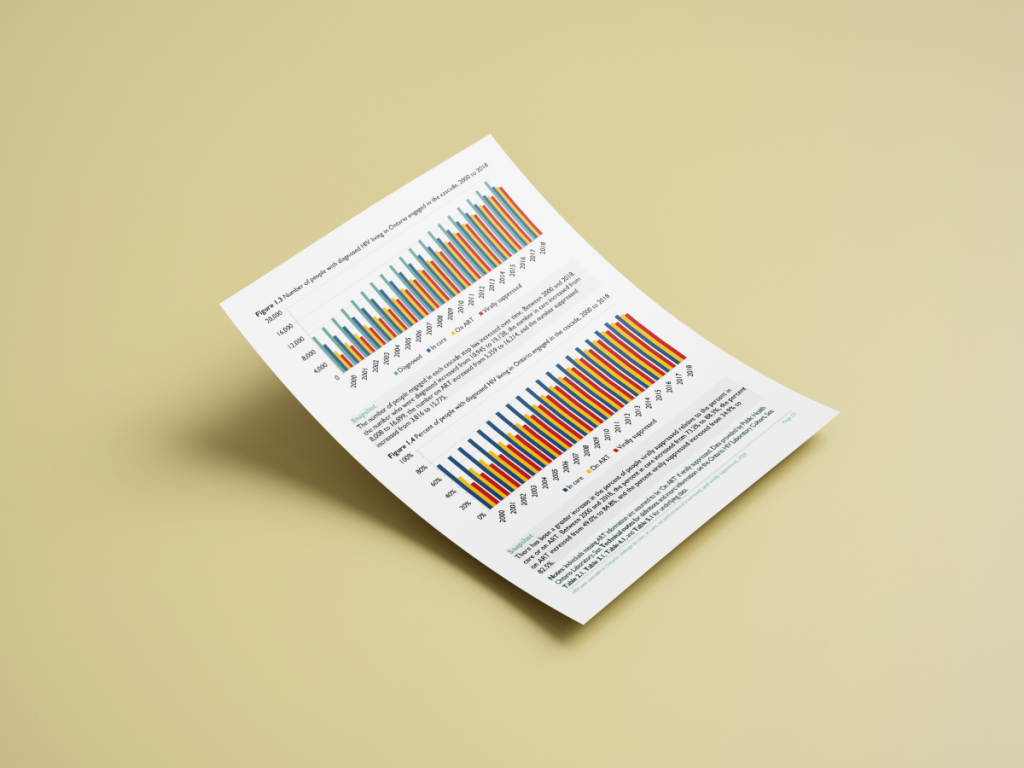The Ontario HIV Epidemiology and Surveillance Initiative (OHESI) is pleased to announce the release of a new report titled “HIV care cascade in Ontario: Linkage to care, in care, on antiretroviral treatment, and virally suppressed, 2018”.
The most effective way to improve the health of people living with HIV and reduce new transmissions is to diagnose HIV infection as early as possible and engage people quickly in care and treatment. Highly effective antiretroviral therapy (ART) can suppress HIV viral load to the point where it is undetectable, cannot cause as much damage to the person’s immune system, and cannot be passed to a sexual partner (undetectable = untransmittable).
Analyzing HIV care cascade data in Ontario is critical to understanding our successes and ongoing challenges in meeting HIV care cascade targets. In the 2018 HIV care cascade report, OHESI describes Ontario’s status in meeting the 2020 UNAIDS 90-90-90 targets, as well as trends between 2000 and 2018 in the number of people living with diagnosed HIV as well as trends in the numbers of people in HIV care, on antiretroviral treatment, virally suppressed and time from HIV diagnosis to being linked to care and achieving viral suppression.
Key findings
Cascade summary:
- An estimated 22,439 people were living with HIV in Ontario in 2018. Of these, an estimated 19,128 people (85.2%) knew their HIV status (ie were diagnosed).
- In 2018, Ontario made progress compared to previous years on the 2nd and 3rd 90s, with 84.8% of people diagnosed on treatment (ART), and 97.3% of people on treatment (ART) were virally suppressed.
Diagnosed:
- An estimated 19,128 people were living with diagnosed HIV in Ontario in 2018.
- The total number of people diagnosed with HIV almost doubled from 2000 to 2018 due to ongoing transmission and people living with HIV living longer. This number also includes people who were diagnosed for the first-time both in Ontario and people first diagnosed elsewhere who now live in Ontario.
Linkage to care and in care:
- The number of people with diagnosed HIV in care has increased steadily over time: from 8,008 in 2000 to 16,899 in 2018 (ie 16,899 individuals had at least one viral load test in 2018). This increase highlights a persistent and increasing demand for HIV-related services.
- More people are in care. The percent of people with diagnosed HIV who were in care increased from 73% in 2000 to 88% in 2018.
- People diagnosed with HIV are linked to care more quickly. The percent of newly diagnosed individuals who were linked to care within three months of HIV diagnosis increased from 67% in 2000 to 85% in 2017.
On antiretroviral treatment:
- More people living with HIV are on treatment. The percent of people with diagnosed HIV who were on ART increased from 49% (5,359 people) in 2000 to 85% (16,214 people) in 2018.
Virally Suppressed:
- More people are virally suppressed. Between 2000 and 2018, the percent of people with diagnosed HIV who were virally suppressed more than doubled from 35% (3,816 people) to 83% (15,775 people).
- The percent of newly diagnosed individuals who had a suppressed viral load within 3 months of HIV diagnosis increased from 6% in 2000 to 33% in 2017 and within 6 months almost tripled from 23% to 66%.
